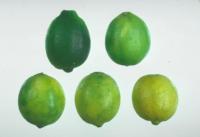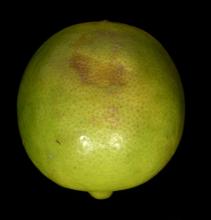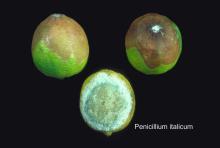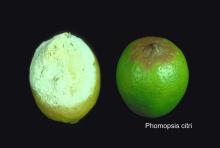Product Description
Indices de Maturité
Juice content by volume of 30% or higher and color (mature-green limes have a much longer postharvest-life than those picked when yellow; the latter must be marketed soon after harvest).
Color (most consumers in the USA prefer green limes but in some other countries consumers prefer yellow limes because of their greater juice content); size; shape; firmness; smoothness; freedom from decay; and freedom from defects including bruises, oil spotting, dryness, freezing injury, and stylar-end breakdown.
Manipulation et stockage post-récolte
10-13°C (50-55°F) depending on cultivar, maturity-ripeness stage at harvest, and duration of storage + transport (up to 6-8 weeks).
| Temperature | 10°C (50°F) | 15°C (59°F) | 20°C (68°F) |
|---|---|---|---|
| ml CO2/kg·hr | 3-5 | 5-8 | 6-10 |
To calculate heat production multiply ml CO2/kg·hr by 440 to get Btu/ton/day or by 122 to get kcal/metric ton/day.
Ethylene causes limes to lose their green color and unmask their yellow pigments, which is undesirable for marketing green limes. Removal of ethylene from lime storage facilities can be beneficial in retarding loss of green color and delaying decay incidence.
90-95%
A combination of 5-10% O2 and 0-10% CO2 retards senescence (loss of green color) of limes, but is inadequate for decay control. Exposure to >10% CO2 and/ or <5% O2 can result in scald-like injury, decreased juice content, off-flavors, and increased susceptibility to decay. Commercial use of CA on limes is very
Temperature & Controlled Atmosphere Photos
Désordres
Chilling injury. Symptoms include pitting, and brown discoloration. Pits Disorders may coalesce and form leathery, brown, sunken areas on the rind. Severity increases with lower temperature below 10°C (50°F) and longer durations of exposure to these temperatures.
Oil spotting (Oleocellosis). Harvesting and handling turgid limes may result in breakage of oil cells in the flavedo and release of the oil that damages surrounding tissues.
Stylar-end Breakdown. This disorder results from rough handling during harvesting and handling. Its severity varies among cultivars and harvest seasons.
Important Diseases:
- Green mold (Penicillium digitatum)
- Blue mold (Penicillium italicum)
- Stem-end rot (Lasiodiplodia theobromae)
- Phomopsis stem-end rot (Phomopsis citri)
- Alternaria stem-end rot (Alternaria citri)
Control Strategies
- Minimizing abrasions, cuts, and bruises during handling
- Treating limes before harvest with gibberellic acid to delay senescence
- Dipping in hot water (50-53°C = 120-125°F) for 2-3 minutes
- Using chlorine in wash water, postharvest fungicides, and or biological antagonists
- Cooling to optimum temperature and subsequent maintenance of optimum temperature and relative humidity
- Avoiding exposure to ethylene
References
References from scientifically validated sources will be added in the future.






